
The Banu Qasi, Banu Kasi, Beni Casi, Banu Musa, or al-Qasawi were a Muladí dynasty that in the 9th century ruled the Upper March, a frontier territory of the Umayyad Emirate of Córdoba, located on the upper Ebro Valley. At their height in the 850s, family head Musa ibn Musa al-Qasawi was so powerful and autonomous that he would be called 'The Third Monarch of Hispania'. In the first half of the 10th century, an intra-family succession squabble, rebellions and rivalries with competing families, in the face of vigorous monarchs to the north and south, led to the sequential loss of all of their land.
The Banu Tujib, the Tujibids or Banu al-Muhajir, were an Arab dynasty on the Upper March of Al-Andalus active from the ninth to the eleventh centuries. They were given control of Zaragoza and Calatayud by the Umayyads as a counterweight to the independence-minded Muwallad nobility of the region. In Zaragoza, they developed a degree of autonomy that served as the precursor to their establishment of an independent Taifa of Zaragoza after the collapse of the Caliphate of Córdoba. They ruled this taifa from 1018 until they were expelled by another Arab dynasty, the Banu Hud, in 1039. An exiled junior line of the family, known as the Banu Sumadih, established themselves as rulers of the Taifa of Almería, which they held for three generations, until 1090.
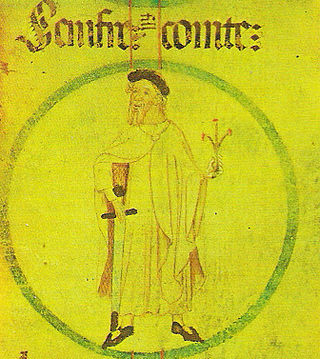
Sunyer was count of Barcelona, Girona and Ausona from 911 to 947.
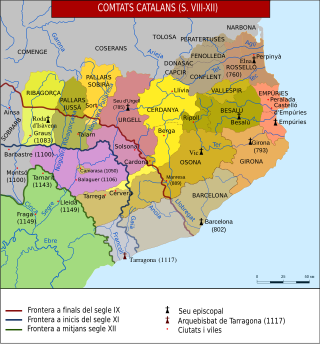
The County of Cerdanya was one of the Catalan counties formed in the last decades of the 8th century by the Franks in the Marca Hispanica. The original Cerdanya consisted of the valley of the upper Segre. Today Cerdanya is a Catalan comarca.
The Battle of Albesa was a follow-up to the Battle of Torà that took place 25 February 1003 at Al-Qaṣr al-Māša (Albesa), near Balagî (Balaguer), between the united Christian forces of the Catalan counties and the Islamic forces of the Caliphate of Córdoba. It was one of the border skirmishes associated with the interminable razzias of the Reconquista, described as "a simple encounter between local forces" and "a local action without overarching importance", though both these views are called into question by the assemblage of important Catalan nobles at the battle and the Muslim reprisal which followed.
Muhammad ibn Abd al-Malik al-Tawil was a Muwallad Wāli of Huesca and a prominent Muslim lord in the Upper March of Al-Andalus in the late-ninth and early-tenth centuries. Acting autonomously from his nominal masters the Emirs of Córdoba, he carried out his own foreign policy and fought both Christian and Muslim regional rivals, including the Counts of Barcelona, Pallars and Aragon, the King of Pamplona and the Banu Qasi of the Upper March. From him arose a short-lived dynasty, the Banu al-Tawil, who would rule Huesca, Barbastro and Lleida, off and on, for a century, eventually losing out to the Banu Tujib of Zaragoza.
Wilfred or Wifred, called the Hairy, was Count of Urgell, Cerdanya, Barcelona, Girona, Besalú and Ausona. On his death in 897, his son, Wilfred Borrell, inherited these counties, known by the historiography as the Catalan counties.
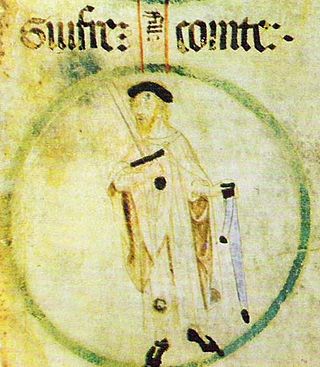
Wilfred II or Wifred II, also known as Borrell I or Borrel I, was Count of Barcelona, Girona, and Ausona from 897 to 911, succeeding his father, Wilfred I the Hairy. His mother was Guinedilda.
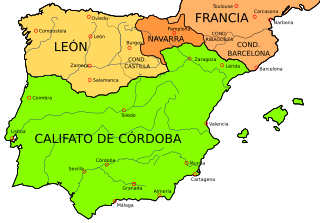
The Battle of Aqbat al-Bakr was a battle of the Fitna of al-Andalus that took place in the area in and around Espiel, Spain. The battle took place between the forces of the Caliphate of Cordoba, whose forces were commanded by Sulayman ibn al-Hakam, and the Muslim rebel forces of the Catalan-Andalusian alliance trying to overthrow their Caliph overlords under the command of Muhammad ibn Hisham; Wadih al-Siqlabi, governor of al-Tagr al-Awsat; and several West Frankish counts and bishops, including Ermengol I of Urgell, Hugh I of Empúries, and Ramon Borrell of Barcelona.

Abū ʿAbd Allāh Muḥammad ibn Saʿd ibn Muḥammad ibn Aḥmad ibn Mardanīsh, called al-Judhāmī or al-Tujībī was the king of Murcia from AD 1147 until his death. He established his rule over the cities of Murcia, Valencia and Dénia as the power of the Almoravid emirate declined, and he opposed the spread of the Almohad caliphate. Christian sources refer to him as the "Wolf King".
Lubb ibn Muhammad ibn Lubb, was a wali of Tudela (890-907) and Larida, as well as a prominent Muslim lord on the Upper March of Al-Andalus.

A Hungarian raid in Spain took place in July 942. This was the furthest west the Hungarians raided during the period of their migration into central Europe; although, in a great raid of 924–25, the Hungarians sacked Nîmes and may have got as far as the Pyrenees.

The Raid of 904 was a military campaign of the Emirate of Córdoba against the counties of Pallars and Ribagorza.
Isma'il ibn Musa was a Muslim lord in the Upper March of al-Andalus, as well as walī of Larida. He hailed from the prominent Muwallad Banu Qasi clan, and was the son of Musa ibn Musa al-Qasawi and his wife Maymuna bint Zahir ibn Furtun, who was Musa's uncle.
Muhammad ibn Lubb ibn Musa, was a Muslim lord who at different times held Zaragoza and Larida, on the Upper March of Al-Andalus.
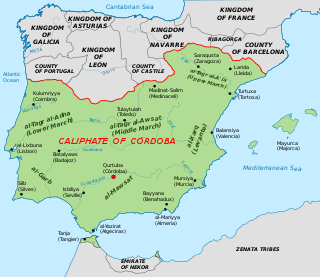
The Upper March was an administrative and military division in northeast Al-Andalus, roughly corresponding to the Ebro valley and adjacent Mediterranean coast, from the 8th century to the early 11th century. It was established as a frontier province, or march, of the Emirate, later Caliphate of Córdoba, facing the Christian lands of the Carolingian Empire's Marca Hispanica, the Asturo-Leonese marches of Castile and Álava, and the nascent autonomous Pyrenean principalities. In 1018, the decline of the central Cordoban state allowed the lords of the Upper March to establish in its place the Taifa of Zaragoza.

The First Battle of Cellorigo took place between the Kingdom of Asturias and the Emirate of Córdoba over the castle at Cellorigo and its surrounding countryside in 882.

The Second Battle of Cellorigo took place between the Emirate of Córdoba over the castle at Cellorigo and its surrounding countryside in 883 AD.
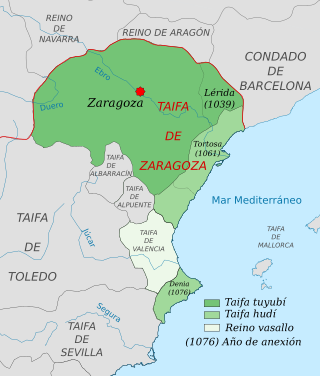
The Taifa of Lérida was a factional kingdom (ṭāʾifa) in Muslim Iberia between 1039/1046 and 1102/1110. Based on the city of Lérida, the ṭāʾifa was not an independent state throughout this period but was sometimes a part of the larger ṭāʾifa of Zaragoza ruled by a governor (wālī).
The Conquest of Balaguer was the capture of Balaguer by Ermengol VI of Urgell from the Almoravids in 1105.











